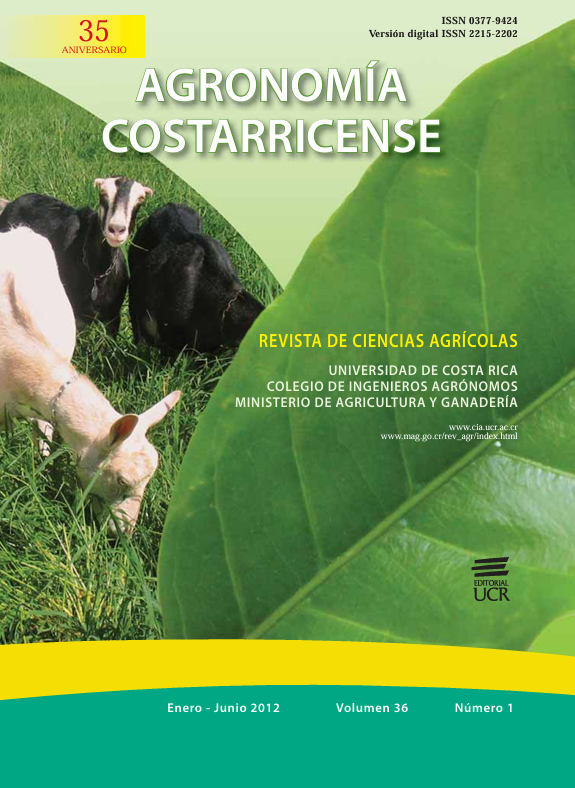Abstract
Modification of fourarm olfactometers to be used with the coffee borer Hypothenemus hampei Ferrari (Coleoptera: Curculionidae). The coffee berry borer, Hypothenemus hampei is considered to be a major pest in coffee producing countries worldwide. As in many insects, the behavior of the coffee borer is modified through aromatic signals. This has triggered important research within the different approaches of olfactometry. Two new innovative designs of olfactometers were evaluated to be used on H. hampei for this research. The olfactometers were built of glass and differ in the angular distribution of their arms and in the insect’s inlet and adaptation zone. A mixture of methanol-ethanol 3:1, with proven attraction properties, was used to evaluate the functionality of these olfactometers. The bioassays were performed using only adult females of H. hampei. On the 90º olfactometer, 45% of the insects were strongly attracted to the arm comprised of the alcohol mixture. In the case of the 30º olfactometer the positive behavior response was only of 1.5%. During the assays it was observed that the different insect insertion strategies into the olfactometers and the adaptation area had a major influence on results. During the second stage of this research, the 90º olfactometer was evaluated through a comparison of the average attraction of each of its 4 arms; there were no significant differences (p<=0.05) in attraction response of H. hampei between arms of the device. It is concluded that the 90º olfactometer design is suitable to develop volatile-compound attraction assays on adult females of H. hampei.
References
BORBÓN O., MORA O. 2000. Proyecto de trampas, atrayentes y repelentes para el control de la broca del fruto del cafeto. In: XIX Simposio Latinoamericano de Caficultura, Costa Rica, 2000, p. 331–348
COLAZZA S., SALERNO D., WAJNBERG E. 1999. Volatile and contact chemicals released by Nezara viridula (Heteroptera: Pentatomidae) have a kairomonal effect on the egg parasitoid Trissolcus basalis (Hymenoptera: Scelionidae). Biological Control 16:310-317.
DEAN G.J., SATASOOK C. 1983. Response of Chrysoperla carnea (Stephens) (Neuroptera: Chrysopidae) to some potential attractants. Bull. Ent. Res. 73:619–624.
DICKENS J.C. 1999. Predatory-prey interactions: olfactory adaptions of generalist and specialists predators. Agric. Forest Entom. 1:47-54.
GEIER M., BOECKH J. 1999. A new Y-tube olfactometer for mosquitoes to measure the attractiveness of host odours. Entomol. Exp. Appl. 92:9-19.
GONZALES W.L., FUENTES-CONTRERAS E., NIEMEYER H.M. 1999. Semiochemicals associated to spacing behaviour of the bird cherry-oat aphid Rhopalosiphum padi L. (Hem. Aphididae) do not affect the olfactometric behaviour of the cereal aphid parasitoid Aphidius rhopalosiphi De Stephani-Perez (Hym. Braconidae). J. Appl. Ent. 123:413–415.
LÓPEZ-ÁVILA A., RINCÓN D.F. 2006. Diseño de un olfatómetro de flujo de aire para medir respuestas olfativas de insectos de tamaño mediano y pequeño. Revista Corpoica–Ciencia y Tecnología Agropecuaria 7(1):61-65.
MATHIEU F., GAUDICHON V., BRUN L.O., FREROT B. 2001. Effect of physiological status on olfactory and visual responses of female Hypothenemus hampei during host plant colonization. Physiological Entomology 26:189-193.
MENDESIL E., BRUCE T.J.A., WOODCOCK C.M. 2009. Semiochemicals used in host location by the coffee berry borer, Hypothenemus hampei. Journal of Chemical Ecology 35:944-950.
MORALES H.E. 1989. Atracción y colonización de Anthonomus eugenii Cano a diferentes solanáceas hospederas: posibilidad de control cultural en chile dulce. CATIE. Turrialba, Costa Rica. 95 p.
OBANDO A. 2002. Levantamiento de un pie de cría de broca del café, Hypothenemus hampei (Coleóptero, Scolytidae) en granos de café y en dieta artificial. Tesis: Ingeniero Agrónomo. Instituto Tecnológico de Costa Rica, San Carlos, Costa Rica. 76 p.
PETTERSON J. 1970. An aphid sex attractant. I. Biological studies. Entomol. Scandinavica 1:63-73. PONSONBY D.J., COPLAND J.W. 1995. Olfactory responses by the scale insect predator Chilocorus nigritus (F.) (Coleoptera: Coccinellidae). Biocontrol Sci. Techn. 5:83–93.
PORTILLA M., STREETT D. 2008. Avances investigativos en la producción masiva automatizada de Broca del Café Hypothenemus hampei Ferrari (Coleoptera: Scolytidae) y de sus parasitoides sobre dietas artificiales. Sistemas Agroecológicos y Modelos Biomatemáticos 1 (1). Julio 2008.
RAPUSAS H.R., BOTTRELL D.G., COLI M. 1996. Intraespecific variation in chemical attraction of rice to insect predators. Biological Control 6, 394–400.
SENGONCA C., KRANZ A. 2001. A modified, four-armed olfactometer for determining olfactory reactions of beneficial arthropods. Journal of Pest Science 74:127–132.
VEGA E., POSADA F., INFANTE F. 2006. Coffee Insects: Ecology and Control. Encyclopedia of Pest Management. pp. 1–4.
VENZON M., JANSSENS A., SABELIS M.S. 1999. Attraction of a generalist predator towards herbivoreinfested plants. Entomol. Exp. Appl. 93:305–314.
VET L.M., LENTEREN J.C., HEYMANS M., MEELIS E. 1983. An airflow olfactometer for measuring olfactory responses of hymenopterous parasitoids and other small insects. Physiol. Entomol. 8:97–106.
WALLER J.M., BIGGER M., HILLOCK R.A. 2007. Coffee Pests Disease and their Management. CAB International, Egham, Surrey, UK. 434 p.


